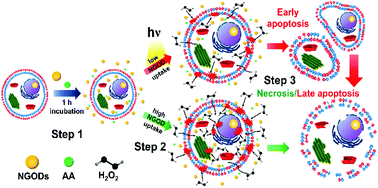Biocompatible hole scavenger–assisted graphene oxide dots for photodynamic cancer therapy†
Abstract
Photodynamic therapy (PDT) receives scholarly attention for its low invasiveness and mild adverse effects. Among the reactive oxygen species for PDT, H2O2 is advantageous for achieving long life and low cytotoxicity. Nitrogen-doped graphene oxide dots (NGODs), which are small (∼4.4 nm) and highly biocompatible, can serve as a photosensitizer for PDT. The charge transfer in NGODs is efficient because the NGOD structure is highly crystalline and its carbon–π orbitals are extensively conjugated with nitrogen-nonbonding orbitals. In the presence of ascorbic acid (AA), to scavenge photogenerated holes, NGODs effectively produce H2O2 under white-light irradiation and their H2O2 rate is proportional to the AA concentration. This AA-supplemented PDT effectively kills lung, head and neck, colon, and oral cancer cells and it is highly safe for normal cells. During PDT, the NGODs are uptaken into the cell body and they produce concentrated H2O2 and subsequently induce both the apoptosis and necrosis pathways for cell death. The unique structure of NGODs confines the transfer of the photogenerated electrons for H2O2 production. This study demonstrates the high potential for efficacious and accurate deployment of the proposed NGOD–AA combination in PDT.



 Please wait while we load your content...
Please wait while we load your content...